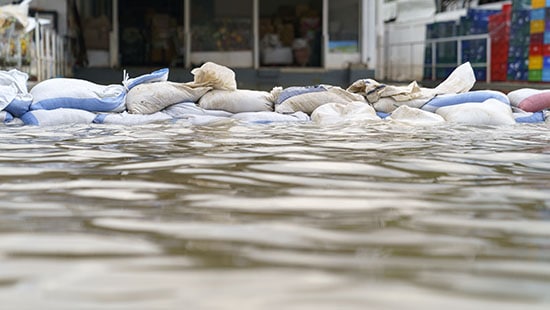
Spring Flooding Creates Prime Conditions for Pests
Spring Flooding Creates Prime Conditions for Pests
Business owners and building managers: If you’re in an area affected by this spring flooding, your focus is certain to be on cleanup and recovery. But in your rush to re-open, don’t ignore a problem that could bite you, literally.
“Flooding can create prime conditions for pests and the risks they pose – from spreading disease to wrecking your hard-earned reputation,” said John Barcay, PhD, Ecolab senior scientist and urban entomologist.
Flooding, rising water and clogged sewer systems send rodents and wildlife running for food and shelter inside structures and under piles of debris. Standing water, along with garbage and other rotting materials, provide resources that flies, mosquitoes, ants and other occasional invaders need to breed. And moisture at building foundations may drive millipedes, centipedes and pill bugs indoors. Overall pests tend to seek higher, dried ground during flooding. So even businesses that remain dry in a flood area risk infestation.
“The severity of pest problems after a flood depends on when and where it occurs and the size of the pest population before waters rise,” said Douglas Gardner, Ecolab corporate scientist who has extensively studied rodents. Early spring flooding in colder parts of the country – places where pest populations may have been reduced by frigid weather – is less likely to create to pest issues than late spring flooding in warmer areas with strong pest populations.
What Should You Do Before Waters Rise, To Help Keep Pests Out?
If flooding is predicted for your area and time allows, it can pay off to partner with your pest management professional to reduce risks. Before waters rise, Ecolab pest control experts recommend that you:
- Identify and seal cracks and other openings under doors and flooring, at pipe chases and in false ceilings. Keep in mind that a mouse can enter through a space no bigger than a dime and a rat through an opening the size of a quarter. In southern and some coastal areas where roof rats live, it’s wise to inspect for and seal access points around the entire building, from the roof to below ground.
- Place rodent bait stations around the outside of your structure to reduce rodent pressure.
- Remove standing water where possible.
What Should You Do as Flood Waters Recede, To Reduce Pest Pressure?
During flooding, protecting life and property must be the primary focus. But as waters recede, “it’s critical to move quickly and step up the intensity of pest management efforts,” said Gardner. “Pests can produce very large populations in a short time.” For example, a female house mouse can begin reproducing at five weeks of age and add 30 to 35 offspring to the population in a year. Insects can lay eggs and proliferate extensively in a matter of days.
As recovery begins, Ecolab pest control experts stress the need for ongoing rigorous inspection, sealing and monitoring. Vigilance should continue well after waters subside as some rodent populations have been known to surge weeks later, after they have re-colonized.
As you work with your pest management professional, Ecolab pest scientists recommend the following actions to help reduce rodents and “occasional invaders” — ants, mosquitoes, flies and other insects that normally live outdoors but come indoors by accident or instinct in search of food, water and shelter.
Rodents:
- Inspect for structural damage. Look for exterior holes and other openings, keeping in mind that some rodents are excellent climbers. Carefully inspect under doorways and around the foundation, and check around pipes and under false ceilings and flooring where rodents can run largely undetected. Prioritize, repair and seal access points. Under doors, install commercial-grade door sweeps.
- Assess exterior bait stations. Replace those that may have washed away or been damaged.
- Repair and replace sodden structural materials. When making repairs, use only industrial-grade materials, the only kind that can stand up under rodents’ powerful chewing. Also, when repairing walls, ask your pest services provider about interior treatments that can act as an additional pest barrier.
- Keep doors closed as much as possible. Inside frequently used doors set multi-catch traps for mice — and monitor for introductions. If there is evidence of rodents indoors, set baited snap traps inside. The traps may not catch all the rats, but they will provide evidence of where additional efforts are needed.
- If monitoring indicates movement of rats and mice in your building, increase outside bait availability and the number of bait stations.
- Identify and remove debris from your property and store garbage in tightly closed containers. Debris and garbage provide ideal harborage for rodents.
- Continue to actively monitor, seal and take other corrective actions as needed.
“Occasional” Invaders:
- Inspect the property for breeding sites and identify pest species present.
- Eliminate standing water outdoors and indoors, including in drains. If drains cannot be dried completely, ask your pest service provider to apply treatments that interrupt the development of insect larvae.
- Promptly store or remove garbage and other organic material that can decay and create prime breeding grounds for insects.
- Repair or replace damaged window and door screens.
- Close up spaces or cracks in the building’s exterior.
- Keep doors and other entry points closed as much as possible.
- Place insect bait stations inside and outside doorways.
Contact Ecolab to learn more about how Ecolab Pest Elimination can help you reduce the risk of pest pressure in your facility, whether it be from a natural disaster or day to day activity.


